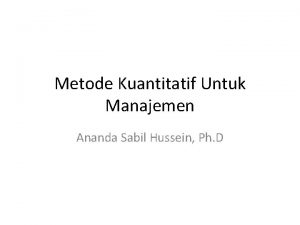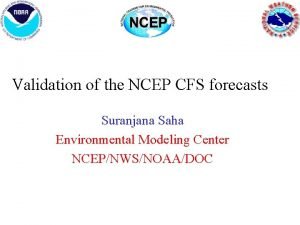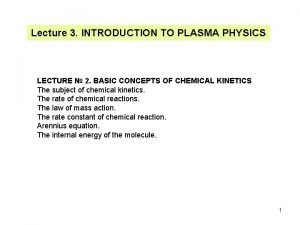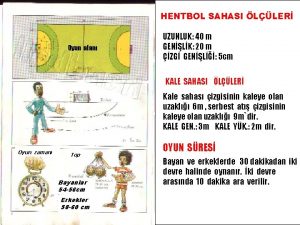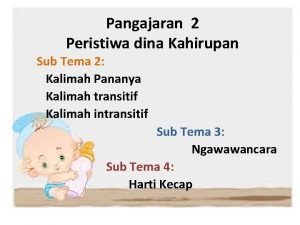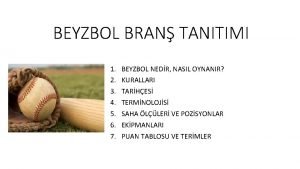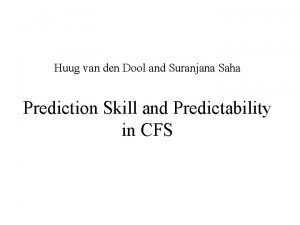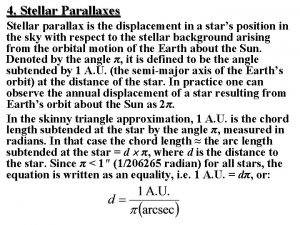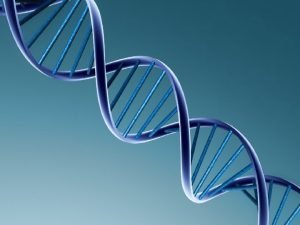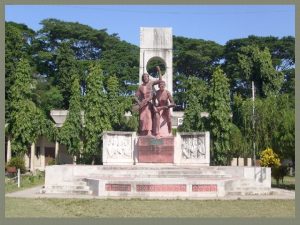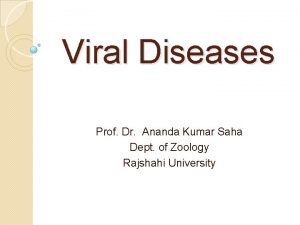Cell Division Ananda Kumar Saha Professor Department of




















- Slides: 20

Cell Division Ananda Kumar Saha Professor Department of Zoology Rajshahi University

Cell Division most the One important of characteristics living the of cells is their power to grow and divide. The cell division is a process by which the cell duplicates itself for growth and reproduction of organisms.

Cell Cycle

Types of Cell Division Two basic types of cell divisions are recognized according to the behavior of the chromosomes. �The daughter cells finish up containing exactly the same number of chromosomes as the parent cell (Mitosis). �The daughter cells finish up with half the total number of chromosomes present in the parent cell (Meiosis).

Initiation of cell division v Some workers suggested that when the ratio of cytoplasm to nucleus is upset then the cell division is occurs. v Gaulden and Prey (1958) have suggested the possibility that the nucleolus has a vital role in the initiating cell division. v The chromosomes and other organelles produce a specific substance which induces the division of a cell. v Initiation of division in the doubling of DNA of the cell.

Amitosis Diagrammatic representation of Amitosis

Amitosis

INTERPHASE Interphase: The resting phase between two mitotic divisions is known as the intermitotic phase or interphase (L. inter- between, phasis- appearance). In interphase no division occours but in the nucleus and cytoplasm active metabolic activities occur and also increase in the volume of the cytoplasmic and nuclear substances take place.

Interphase

INTERPHASE Following events occur: v The nuclear envelop remains intact v The chromosome occurs in the form of diffused, long, coiled and indistinctly visible chromatin fiber. v The DNA amounts become double v The centriole is surrounded by a clear and dense zone v The centriole divides into two centrioles.

Prophase � The prophase (gr. , pro-before, phasis-appearance) is the actual first phase of the mitosis. Ø The disintegration of nuclear envelop starts Ø Both chromatids remain connected with each other by centromere Ø The chromatids become shortened and thickened Ø The nucleolus starts to disappear Ø The centrioles separate and migrate towards the opposite poles of the cell.

Prometaphase �Promataphase: (Gr. , Pro-before, meta –after, phasis-appearance) following changes usually occur in the cell. �The nuclear membrane completely disintegrates �The Chromosome move towards the equator

Cell Division

Metaphase � � Metaphase: (Gr. , meta-after, phasis-appearance) � Each chromosome reaches to the equator and all arrange themselves readily at the periphery of the spindle. � The smaller chromosomes usually remain towards the interior, while the larger chromosomes remain at the periphery. � Some of the fibres or microtubules of the spindle attach with the centromere of each chromosomes and are known as the chromosomal fibre. � Some of the fibres or microtubules of the spindle remain attached from one end to the other end with the centrioles and are known as continuous fibre. � � �

Anaphase � v Anaphase : ( gr. , ana-up, phasis-appearance) v The centromere of the each chromosome divides into two. v The chromatids of the each chromosomes are separated and form two chromosomes. v The chromosomes become shorter and thicker and migrates towards the opposite poles of the cell. v The migration of the daughter chromosomes towards the opposite poles is achieved by the contraction of chromosomal fibres and the stretching of interchromosomal or interzonal fibres. The interzonal fibres push the daughter chromosomes towards the opposite poles.

Telophase at the opposite poles �The chromosomes which reach of the cell now elongate, the coils of DNA protein fibers loosen and the chromosomes become thread like. �The nucleolus reappear � The endoplasmic reticulum forms the new nuclear envelope around the chromosomes and the nucleolus. �The microtubules of the aster and mitotic spindle rearrange and disappear. �Thus, after the telophase two daughter nuclei are formed due to the cytokinesis. The karyokinesisis followed by the cytokinesis.

Mitosis

Cell Division Mitosis

Significance of Mitosis v The mitosis helps the in maintaining proper size. v It helps in the maintenance of equilibrium in the amount of DNA and RNA in the cell. v The mitosis provides the opportunity for the growth and development to organs and the body of the organisms. v The old decaying and dead cells of the body are replaced by the help of mitosis. v The gonads and the sex cells depend on the mitosis for the increase in number.

 Classroom salon
Classroom salon Ananda sabil hussein
Ananda sabil hussein Ananda aged care
Ananda aged care Events of the cell cycle
Events of the cell cycle Cell cycle and cell division
Cell cycle and cell division Cell cycle chart
Cell cycle chart Promotion from associate professor to professor
Promotion from associate professor to professor Voleybol direk ölçüleri
Voleybol direk ölçüleri Suranjana saha
Suranjana saha What is plasma to gas called
What is plasma to gas called Hentbol oyun kuralları
Hentbol oyun kuralları Eskrim pisti ölçüleri
Eskrim pisti ölçüleri Saha ngaran narasumber
Saha ngaran narasumber Tridib saha
Tridib saha Beyzbol sahası ölçüleri
Beyzbol sahası ölçüleri Suranjana saha
Suranjana saha Saha gözlem ziyaretleri
Saha gözlem ziyaretleri Dr soma saha
Dr soma saha Kumar
Kumar Saha equation
Saha equation Tsg export sa
Tsg export sa

